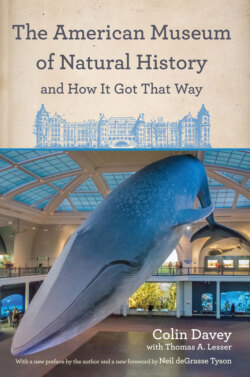Читать книгу The American Museum of Natural History and How It Got That Way - Colin Davey - Страница 10
На сайте Литреса книга снята с продажи.
ОглавлениеHow This Book Came to Be Written
Colin Davey
T his book would have never been written if I, like so many New York City children, had not grown up visiting the American Museum of Natural History and the Hayden Planetarium countless times as a youngster.
My mother, a native New Yorker who taught science in the city’s public schools, herself made regular visits to the museum and planetarium when she was young. And as was the case for so many New Yorkers, the museum and planetarium were a favorite destination for family outings for as long as I can remember. I learned to read at the museum. My mother tells the story of how, when I was three or four, I would look at the exhibits and spell out the labels: “T-i-g-e-r … Tiger!” “B-e-a-r … Bear!” “B-l-u-e m-a-r-l-i-n … Fish!”
When I was a student, the museum and planetarium were frequent destinations for field trips. The museum’s gift shops and the planetarium’s Book Corner were my parents’ go-to destinations for birthday and Christmas presents. Like so many young visitors to the museum, then and now, I was enchanted by the amazingly lifelike dioramas that recreated remote terrains and their unfamiliar inhabitants. I was held spellbound by the reassembled skeletons of dinosaurs, exotic creatures who had roamed Earth tens of millions of years ago. I was mesmerized by the star show at the planetarium and the image of distant heavenly bodies arching through a dark night sky.
I began going to the museum on my own at the age of seven. I visited so often that a planetarium employee eventually recognized me and introduced himself, saying, “From now on, you get in for free. Just say you’re with me, Mark Twomey. I work at the Book Corner. To remember my name, just think ‘Twomey, as in sock-it-to-me.’” At the time, “sock it to me” was a catchphrase from the popular TV show Laugh-In, a phrase that even presidential candidate Richard Nixon had uttered during a cameo appearance on the show. I haven’t seen Mr. Twomey since I was seven in 1967, but I would be delighted to remake his acquaintance. If any reader knows him, please put him in touch with me!
The first time I saw the full glory of the night sky far from the smog and light pollution of New York City, where even on a clear night only a handful of stars are visible, I remember gasping, “It’s just like the Hayden Planetarium!” The visits to the museum and the planetarium awoke in me a curiosity about science and a scientific way of thinking that would stand me in good stead for my entire life.
Despite my passion for the museum, one thing I remember clearly about all those visits was that I never had any idea exactly where I was in that vast space or how to get from one place to another. For decades, being lost at the museum became a recurring dream. This, no doubt, led to my desire to better understand the museum’s physical structure.
Flash forward to 2010. I had been living for three decades in Eugene, Oregon, and was working as a software engineer in the field of neuroscience. I had also developed a deep interest in New York City’s history and architecture. Around this time, I began looking for information about the original Hayden Planetarium, which had been demolished in 1997 to make way for the new Rose Center for Earth and Space. To my surprise, information was hard to find. Google searches on “Hayden Planetarium” resulted almost entirely in links about the Rose Center rather than about the original planetarium.
Digging deeper, I discovered some resources on eBay and elsewhere. Most importantly, I met Thomas A. Lesser, whom I found through one of his online comments about the memorable dreamlike scene in Woody Allen’s 1979 movie Manhattan that is set in the darkened planetarium. Dr. Lesser had been a senior lecturer at the planetarium from 1975 to 1982, after which he held various management positions at the museum. Thus began the collaboration leading to the idea for a book titled The Heavens in the Attic: The Original Hayden Planetarium, 1935–1997. In that process, we were encouraged by Neil deGrasse Tyson.
In the process of researching The Heavens in the Attic, I learned a great deal about the museum’s structure and physical history. I realized that an understanding of its history and architecture could profoundly enhance the experience of visitors and be a valuable aid in navigating the exhibition halls. I also realized that much of this information was not readily available. Thus the idea for a second book: The American Museum of Natural History and How It Got That Way.
Perhaps inevitably, it became apparent that these were not two books but rather two halves of a single work. This book is the result.
